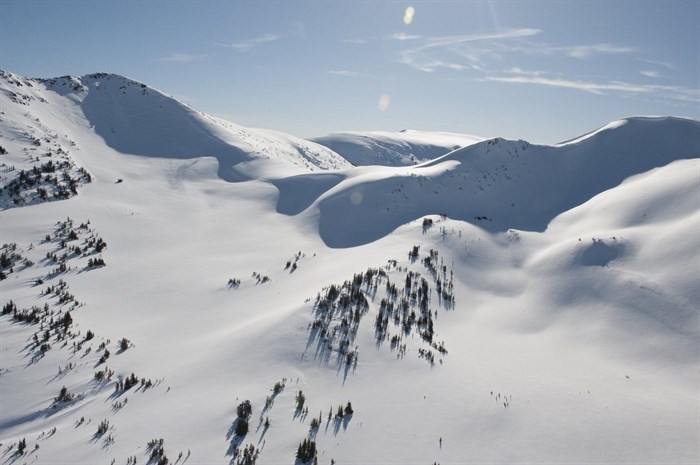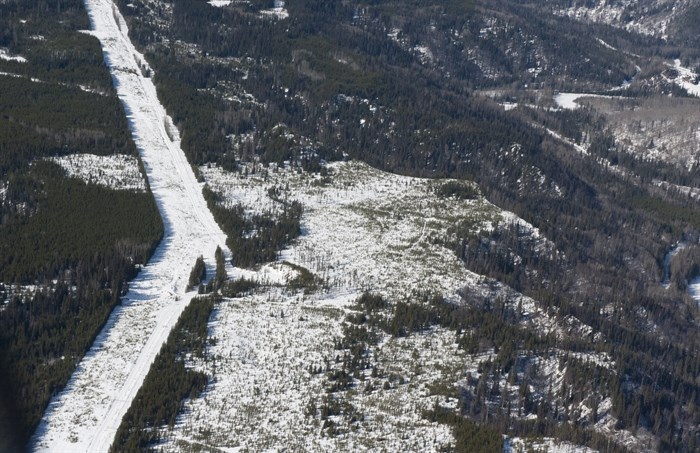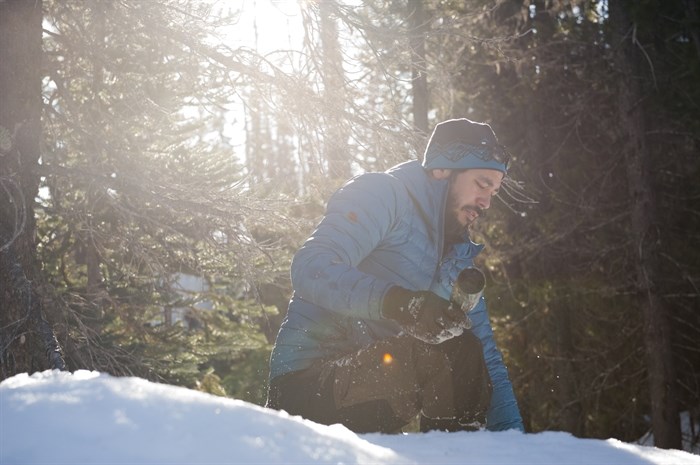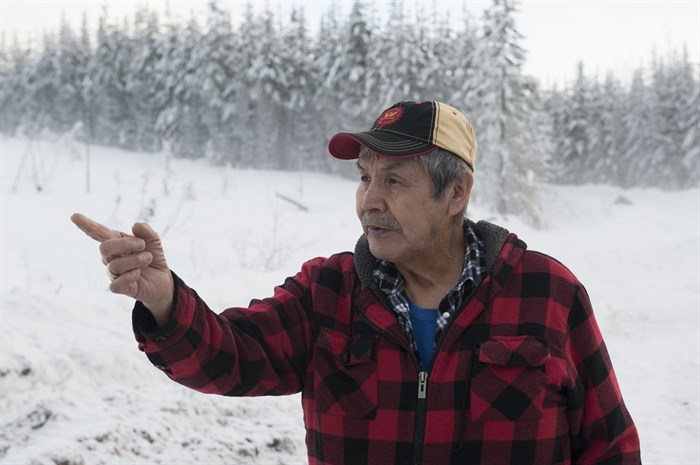
On Wet'suwet'en territory, a shrinking pocket of mountainous habitat is all that remains for the last of the widzïh (caribou) that once roamed freely over 22,000 square kilometres.
Image Credit: Matt Simmons, Local Journalism Initiative
May 20, 2023 - 9:00 PM
There’s a serene pocket of mountainous habitat in northwest B.C. where 33 caribou live, drinking from glacial-fed creeks and grazing on alpine lichens. Though it’s peaceful, they have nowhere to go. They’re surrounded.
They’ve been cut off from where they gave birth to their young and the tracts of land that supported them through the long northern winters by highways, hydroelectric dams, rail lines, clearcuts and farmland. The herd’s range has been fragmented for more than a century and faces imminent threats.
Before nïdo (settlers) arrived on Wet’suwet’en territory and started extracting resources from the land, this was a place of abundance. There were thriving salmon populations in the rivers, goats in the mountains and bears, martens, wolves, groundhogs and grouse everywhere in between. Massive herds of widzïh (caribou) roamed the 22,000 square kilometre territory. As settlers built infrastructure and spread out across the landscape, the widzïh retreated. Predators in increasing numbers, both human and animal alike, took advantage of the new packed trails and logging roads to track and kill the animals, pushing the survivors deeper into an ever-shrinking habitat.
Pre-colonization, widzïh on the landscape were simultaneously an indicator of ecological health and cultural wealth. For the Wet’suwet’en, the animals were not only integral to numerous ecosystems, from wetlands in the valley bottoms to subalpine forests and stretches of tundra, they were also a vital source of sustenance, raw materials for clothing and tools, and a valued trade item. With just a few dozen left of what’s known as the Telkwa herd, a subpopulation of southern mountain caribou, the Wet’suwet’en can’t hunt widzïh anymore.

Surrounding the remaining widzïh habitat, human impacts including agriculture, forestry, rail and transmission lines constrain the herd’s ability to grow.
Image Credit: Matt Simmons, Local Journalism Initiative
Across the province and across the country, caribou populations have been in steady decline for decades. Herds in B.C. have started winking out, as industrial logging and other incremental cuts into caribou habitat push populations into smaller and smaller areas. Since 2005, the province has lost eight deep-snow herds and the 10 that remain all face local extinction.
In a last-ditch effort to save the Telkwa herd, the B.C. government set up a 2,300 square kilometre wildlife habitat area in 2016. It had already banned hunting in the early 1970s and augmented the population with animals from a neighbouring herd in the late 1990s. Now, a small team of provincial biologists are fighting to keep the herd from disappearing forever.
But as TC Energy builds the Coastal GasLink pipeline through the range, opening up a vast linear corridor to opportunistic predators like wolves, and an Australian mining company pushes forward with plans to build an open-pit coal mine in a corner of the habitat, the future of the widzïh is uncertain.
‘Maternal lineage of knowledge’ being lost with caribou
From above, it’s easy to see the boundaries that currently constrain the widzïh. To place the habitat in the context of impacts that have eaten up the animals’ range, Mark Wong, a biologist with the provincial caribou recovery program, invited The Narwhal on a routine helicopter flight to retrieve equipment.
From Smithers, B.C., you first fly over a patchwork of clearcuts and switchbacking logging roads that stand out from the deep green trees. Beside the Telkwa River, a snow-covered swath marks the path of a transmission line.
“This is one of the last spots where harvest was allowed,” Wong said, pointing out a logged area on the edge of what he explained is now protected.
In 2018, with less than 20 adults alive, B.C. started controlling access to the area, prohibiting snowmobiles and other motorized vehicles, except in limited circumstances. That’s because widzïh spook easily and winter predators take advantage of the tracks set by machines through the fluffy snow.
“It’s a lot easier to travel on a packed trail than it is to try to hoof it through the deep snow,” Wong, the head of the small Smithers-based team, told The Narwhal. “And then you’ve got that inherent noise disturbance that can cause stress for animals to the point where they may not use that habitat anymore.”

Mark Wong, a B.C. ecosystems biologist, retrieves a camera that was mounted on a tree beside a path used by snowmobilers. When the areas are closed to motorized traffic, the government team works with the local snowmobile clubs to ensure the public stays out, but camera traps are set up to catch anyone ignoring the rules.
Image Credit: Matt Simmons, Local Journalism Initiative
Caribou have long memories. According to Len Vanderstar, a retired habitat protection biologist, the behaviour of the herd has changed over the past 10 years or so. He said pregnant females used to travel to the valley bottoms when the first green vegetation — grasses, shrubs and lichens — emerged after the long northern winters.
“They would come down and get that nutrient boost and then within two weeks give birth up in the subalpine,” he explained on a phone call. “That trend doesn’t exist anymore. What we suspect is that all the cows that used to do that are no longer alive — they were killed by predators. That’s no longer part of their maternal lineage of knowledge they pass down from generation to generation.”
The vehicle closures seem to be helping — the herd’s population is creeping back up and data shows the animals are tentatively starting to access new areas, including returning to lower elevations to feed on their favourite lichens.
But as B.C. works to protect what little remains and plan for the future, it’s unclear how the population will be able to grow, as available habitat continues to be taken up by industrial development.
Habitat constraints from Coastal GasLink limits potential population growth
In 2020, Rosemary-Claire Collard and Jessica Dempsey, with Simon Fraser University and the University of British Columbia, respectively, reviewed more than three decades of environmental assessments to see what, if anything, the government process was doing to prevent local extinction, known as extirpation, of caribou herds.
An underlying problem is the assessment process doesn’t scope in the future health of a herd like the Telkwa population, Dempsey said.
“They use degraded environments regularly as justification for more development.”
“We found that environmental assessment is not planning for recovery,” Collard added. “That wasn’t actually the case with Coastal GasLink because it was one of the rare cases where they found that there would be significant effects for caribou but they went ahead with the project anyway.”
When the province approved the pipeline project in 2014, it laid out a suite of conditions and obligations aimed at minimizing impacts to the herd.
Coastal GasLink was required to “develop and implement a caribou mitigation and monitoring plan and participate in a program of activities that supports the recovery, conservation and management of caribou.” That included providing $1.5 million to fund “caribou and predator monitoring to avoid increased predation associated with habitat disturbances,” a government spokesperson wrote in an email to The Narwhal.
That $1.5 million wasn’t just for Wet’suwet’en widzïh — the 670-kilometre pipeline project transects other herds’ habitats, including the Quintette caribou on Treaty 8 territory.
The company is expected to reduce project activities during “critical timing windows” but only “to the extent practical.” If construction or other related activities are expected to “begin within or extend into the critical or cautionary periods” the plan dictates the company has to implement extra mitigation measures. Those, in essence, simply say: work faster. The plan also concedes that “implementation of these measures may be affected by factors beyond Coastal GasLink’s control, such as adverse weather conditions and safety considerations.”
In other words, there’s scant accountability to make sure the work isn’t noisy and disruptive. To Vanderstar, who worked for decades trying to save the Telkwa herd while he was employed by the B.C. government, it’s a moot point.
“You won’t find caribou going into where there’s industrial activity — period, end of story,” he said.
On the surface, that’s a good thing as it means the animals aren’t directly affected by pipeline construction, but it also means the herd doesn’t have room to grow. And where Coastal GasLink is being built happens to be perfect habitat, Vanderstar explained.
“It’s going through a terrestrial lichen site near the Unist’ot’en camp,” Vanderstar said, referring to a Wet’suwet’en land-based healing centre where the RCMP arrested chiefs and matriarchs in 2020 as they tried to stop pipeline construction. “That was winter low-elevation habitat and the pipeline is going right through it.”
Driving up the dirt and gravel road to get to pipeline worksites on the territory means passing signs that flag the boundary of the widzïh range. The main thoroughfare, which follows the Wedzin Kwa (Morice River) for long stretches, is used by hundreds of industry vehicles daily.
Even after construction is completed and things quiet down, Vanderstar said the pipeline right-of-way will still displace the animals.
“We’ve got massive linear corridors facilitating wolf access during the summertime,” he explained. “And in wintertime, there’s probably no talk about eliminating or trying to prevent packed trails from snowmobiles, because it’d just be fun snowmobiling down the whole linear corridor.”
A government spokesperson pointed to an access control management plan the company has to develop and implement. The plan is intended to guide “post-construction efforts to control all vehicle use of the right-of-way” but the 126-page document only mentions snowmobiles once, in reference to access during construction. After the pipeline is built, the company “may include the use of woody debris as rollback, mounding, placing boulders across the [right-of-way] and installing gates and signs” to control vehicle access, according to the guidance document.
Vanderstar isn’t convinced.
“You can pretty well write that whole south side of the Morice off for any future occupancy of caribou,” he said.

Alpine plateaus remain one of the few places widzïh survive. As industry continues to take up space around and in the habitat, it’s unclear how the population can grow.
Image Credit: Matt Simmons, Local Journalism Initiative
Telkwa coal mine proposed for forest still healing from logging impacts
Closer to the Telkwa River and its namesake village just south of Smithers, the proposed Tenas coal mine project, owned by Telkwa Coal Limited, would be built within the wildlife habitat and recovery area, if approved. Majority owned by Australian mining company Allegiance Coal, the mine would produce up to 825,000 tonnes of steel-making coal annually. Estimated to sprawl over 1,000 hectares of land above tributaries of the Telkwa River, the industrial site would cover areas historically used by the widzïh.
According to 30 years of data collected between 1986 and 2016, the animals haven’t been at the proposed mine site for years, instead centring their movements in an area around 10 kilometres away from the proposed site. But Vanderstar and local community members are concerned about the impacts of blasting and other industrial noise.
“According to GIS analysis we’ve done, if you draw acoustic displacement impact around that mine development site and the road, it takes up 19,000 hectares of the caribou habitat,” he said.
He added building the mine and associated infrastructure would also raze areas that will become suitable habitat as the land heals from decades of industrial logging.
“We used to have animals coming down to the Telkwa River from Tenas, from the Goathorn Creek,” he said. “It’s getting hardly any use right now but we’ve got these forests that are growing back and they’re growing back with arboreal lichens. They’re going to knock them all down for the mine.”
Telkwa Coal, a subsidiary of Allegiance managing the proposed project, did not provide an interview to The Narwhal prior to publication.
‘Now there’s nothing’
The Telkwa caribou are considered threatened federally and blue-listed provincially, which means a species of special concern. But the herd’s population has been plummeting since colonization and its numbers dropped to single digits in the 1990s. According to the province, the downward trend over the decades puts the herd at “continual risk of extirpation.” Because conservation status is not applied to individual herds, the imminent threat to widzïh doesn’t trigger protections afforded to endangered species.
For the Wet’suwet’en, extinction is extinction. That caribou herds roam across other territories doesn’t restore what they will lose if the widzïh disappear from their homelands forever.
In 1997, the late Hereditary Chief Alfred Joseph, who held the name Gisday’wa and was one of the lead plaintiffs in a landmark court case on Indigenous Rights and Title, recounted an Elder’s teachings about widzïh.
“They didn’t just hunt for themselves. They hunted for the village. All they brought back was the tongue. And when they hit the door with that tongue, the people knew, ‘Oh tomorrow we go out and pack all that meat in.’ ”
When a landslide blocked the passage of salmon up Wedzin Kwa (Morice River) around 1824, Wet’suwet’en families settled in the village of Tsë Cakh on neighbouring Gitxsan Nation territory. To negotiate the arrangement, a delegation took widzïh hides as gifts.
These connections to widzïh are severed and it remains to be seen whether they can be restored.
In 2020, Jennifer Wickham, a member of the Gidimt’en clan, penned a poem about the loss.
My ancestors ate caribou
and yet there is no-one in my family to tell me what they taste like
Alcan drowned what was left after the CN railway cut them off
I mourn them often
full chest heaving painful sobs like I’m being crushed by the loss
but when I talk about them my words just dissipate
The current Chief Gisday’wa, whose English name is Fred Tom, said he remembers when the wide road used by pipeline construction crews that now cuts through the herd’s range was a meandering path.
“It was just a little trail here and bush everywhere,” he told The Narwhal. “On my territory, I used to come out here and get my moose every year, sometimes two in one day because there was a lot of them in those days. Now there’s nothing.”

Wet’suwet’en Hereditary Chief Gisday’wa witnessed the displacement of wildlife on his territory from decades of forestry and, more recently, the Coastal GasLink pipeline.
Image Credit: Matt Simmons, Local Journalism Initiative
Vanderstar fears the pipeline, ongoing forestry and the proposed coal mine are stacking the odds against efforts to recover the species.
“Caribou will go to substandard habitat to avoid predators and human disturbance. At some point, you’ve got the straw that breaks the camel’s back.”
But while pipeline construction continues and the widzïh stay away from the disturbance, B.C. has yet to make a decision about the proposed mine. In December, the province rejected the Sukunka coal mine in northeast B.C., mainly on the grounds it would have negative implications for the Quintette caribou herd.
“As proposed this project currently threatens the existence of the already-precarious Quintette herd and would be contrary to the goal of sustainable development in the area,” B.C. Minister of Environment and Climate Change Strategy George Heyman and Minister of Energy, Mines and Low Carbon Innovation Josie Osborne wrote in their decision.
“We are in recovery mode,” Vanderstar stressed. “Everything should be looked at from that lens. You can do all the monitoring in the world and you can get the money to do it but you’re still [contributing] to the demise and extirpation of the animals because you’re still cumulatively impacting the habitat that much more.”
To him, the proposed coal mine should be a non-starter.
“If we’re going to be serious about caribou recovery, we have to get serious about caribou habitat recovery. Why are we even entertaining further development in that area?”
Banking low over a bridge that crosses the river, the helicopter offers a vantage point over a snow-covered track that snakes through the forest up into the mountains. It’s one of the only motorized access points into the area where the few remaining widzïh survive.
The helicopter touched down in a clearing, the surrounding pines flexing away from the rotor wash as if trying to escape from the disturbance. When the machine’s sound subsided and the trees straightened, Wong and resource technician Courtney Griffis clambered out onto the crusted snow. They came here to retrieve a camera trap, set up to relay a satellite notification to the government team and conservation officers when anyone ignores closures.
A camping cooler buried in the snow houses a battery and the electronic equipment, which they dig out, marvelling at how much snow fell this spring. The cameras mounted on nearby trees are hard to spot, unless you’re really looking for them.
Wong said they’ve developed a healthy relationship with the local snowmobile clubs, so it’s not often someone ignores the closures. Raising his young family in Smithers, he’s acutely aware of small-town dynamics and the need to work together to find solutions. But the importance of keeping humans away from the animals can’t be overstated.
“Our last survey in 2020 we counted 33 individuals,” he said. “We are seeing an increasing trend over the last eight years but it’s at a level that we want to make sure we’re still doing the best that we can for the herd.”
After removing the cooler and the cameras, Wong and Griffis fill in the hole and cart the equipment back to the helicopter. It’s nearing the end of snowmobiling season and they need to change out the battery.
Getting a ping to say errant sledders crossed into a closed area might be exciting and set into motion an enforcement deployment, but the best satellite data that shows up on Wong’s computer is from collars attached to seven widzïh. The biologists only tag adult females, to track population growth (or decline) and keep an eye on maternal movements as pregnant females prepare to give birth and raise their young.
“When you see something that’s maybe different, looking at the collar data over a couple of years, and you see, oh wow, that girl’s way over here, that makes you smile,” he said. “Whether they’re exploring or dispersing or looking for different areas or using different habitat, as the herd grows, they’re going to need more space. Knowing that they’re out there and doing some different things gives you a bit of optimism.”
He said getting out in the field is always welcome, even if it’s to study an animal that died. In addition to taking samples, they look at things like snow conditions, predator tracks and evidence of avalanches.
“It’s important to be able to see the landscape that you’re working with. All those things kind of feed into getting a better understanding of your herd or your population,” he said.
Knowledge of the past — what the land was like, how big the herd was, the habitat it once used and the roles it played — can be used to make decisions about the future, Wong added.
“Who do we need to work with? Are there other knowledge holders that can help us identify some of those important areas? Looking at what used to be, what’s the state of things now, what can be done going forward — we need to bring everyone along on that journey.”
Vanderstar said it could take up to a decade to build the herd up to more than 100 animals, a population size that would be better for genetic diversity, and the available range could support close to 300.
Repairing the fragmented landscape to expand available habitat will require gargantuan efforts — but that doesn’t mean it’s impossible. The process has already started, albeit slowly and on a small scale. In 2019, the Society for Ecosystem Restoration in Northern B.C. worked with the province and the Office of the Wet’suwet’en, an administrative branch representing the nation’s Hereditary Chiefs, to draft a tactical restoration plan aimed at improving habitat health in the core areas.
On a practical level, that means using heavy machinery to loosen compacted soils to promote regrowth, planting trees and shrubs and using debris leftover from logging to break up linear corridors, reducing predator access. If these initial attempts prove successful, the methods can be scaled up to start expanding the herd’s range.
Because the underlying causes of caribou decline are cumulative, complex and stretch back more than a century, it can sometimes seem hopeless when trying to navigate solutions. But Collard said the opposite is also true.
She explained that because there are so many different forces causing biodiversity collapse and multiple pressures on caribou, that means there are just as many opportunities for individuals to get involved in creating positive change.
“There’s a lot of different entry points into ecological problems,” she said.
Wong echoed the idea.
“It’s those cumulative actions that we do that might help bring those animals back.”
— This story was originally published by The Narwhal.
News from © iNFOnews, 2023